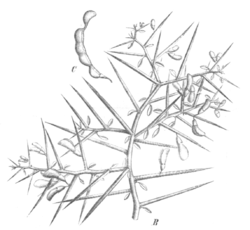| Alhagi | |
|---|---|
 | |
| Alhagi maurorum | |
| Scientific classification | |
| Kingdom: | Plantae |
| Clade: | Tracheophytes |
| Clade: | Angiosperms |
| Clade: | Eudicots |
| Clade: | Rosids |
| Order: | Fabales |
| Family: | Fabaceae |
| Subfamily: | Faboideae |
| Tribe: | Hedysareae |
| Genus: | Alhagi Tourn. ex Gagnebin (1755) |
| Type species | |
| Alhagi maurorum Medik. | |
| Species [1] | |
| |
| Synonyms [1] | |
MannaD.Don (1825) | |





Alhagi is a genus of Old World plants in the family Fabaceae. They are commonly called camelthorns or manna trees. There are four accepted species, which range from northern Africa and Greece through western and central Asia to India and northern China. [1]
Contents
Alhagi species have proportionally the deepest root system of any plants[ citation needed ] - a 1 m (3 ft 3 in) high shrub may have a main root more than 15 m (49 ft) long; due to their deep root system Alhagi species are drought-avoiding plants that utilize ground water, adapting in that way perfectly to the hyper-arid environment.
Alhagi species are used as food plants by the larvae of some Lepidoptera species including Coleophora argyrella which feeds exclusively on A. maurorum.